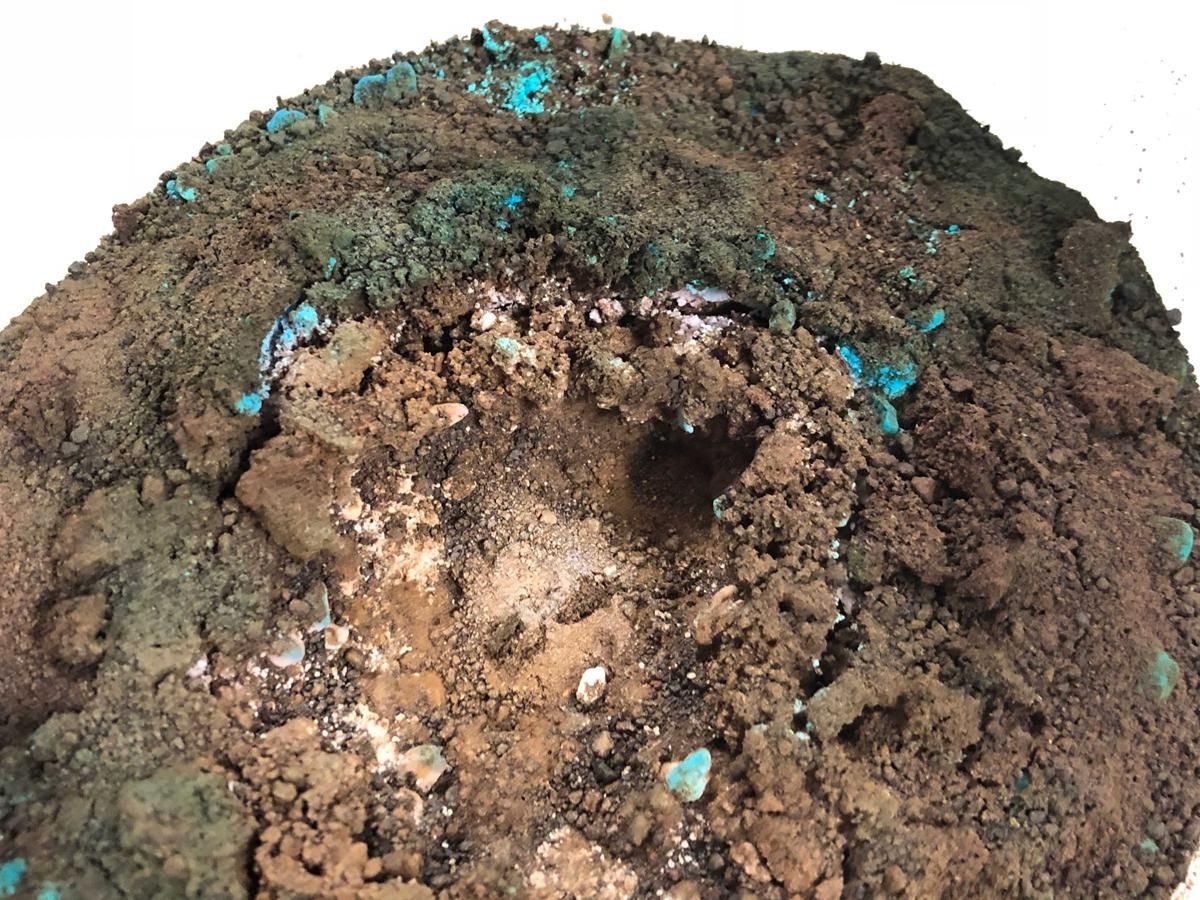
Janice Bishop, senior research scientist at the SETI Institute and lead of a study about Recurring Slope Lineae formation on Mars, is “excited about the prospect of microscale liquid water on Mars in near-surface environments where ice and salts are mixed with the soil. This could revolutionize our perspective on active chemistry just below the surface on Mars today.”
Researchers at the SETI Institute say that mysterious dark streaks on sun-facing slopes on Mars, debated about for years, may be small landslides caused by a combination of salts and melting ice just below the surface.
A new theory by a team of researchers from the SETI Institute’s NASA Astrobiology Institute suggests that the mechanism of the streaks is small-scale ice melting in a loose blanket of dust, broken rocks, and other materials near the Martian surface. (EarthSky)
- EarthSky: Dark streaks on Mars may be caused by salts and melting ice
- SETI.org: Martian Landslides Caused by Underground Salts and Melting Ice?
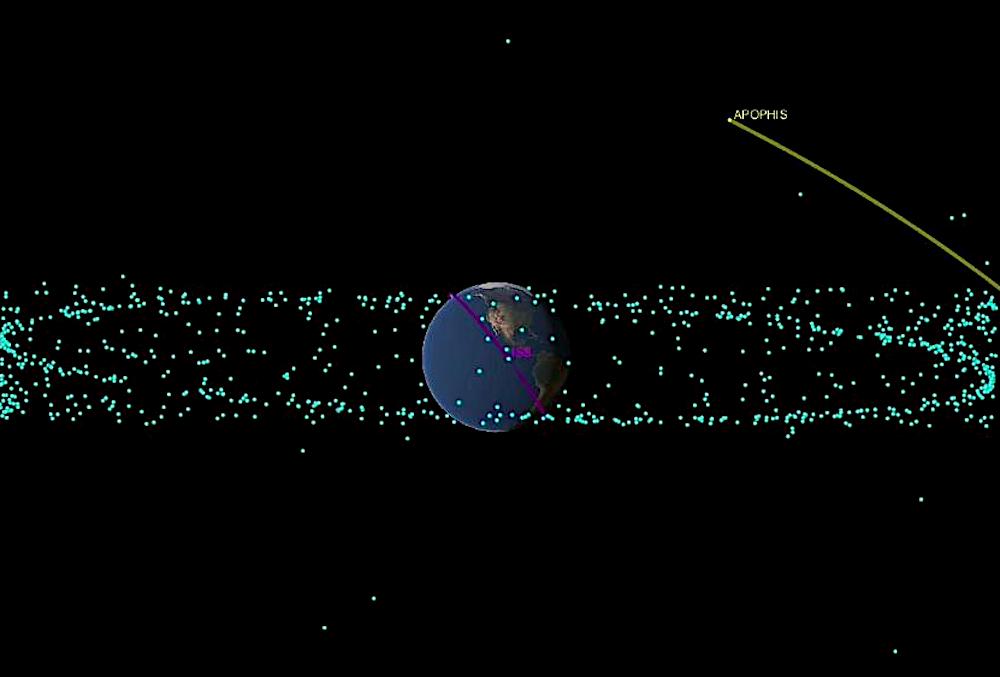 Planetary defense plan activated: Astronomers appeal to observe Apophis asteroid, which will graze Earth in 2029 and 2068
Planetary defense plan activated: Astronomers appeal to observe Apophis asteroid, which will graze Earth in 2029 and 2068Expected to pass dangerously close to Earth in coming years, the Apophis asteroid was the recent target of citizen astronomer observations. Using the eVscope, developed by Unistellar for convenient use from home, citizen astronomers responded to a challenge to observe the Apophis asteroid as it passed by a bright star.
"One of the great mysteries about Apophis is how its orbit changes when the asteroid is illuminated by the Sun; this Yarkovsky effect is very difficult to simulate, so direct observation of an occultation - the asteroid passes in front of a star - will give us greater precision of the asteroid's position," explained Franck Marchis, senior astronomer at the SETI Institute (USA) and chief scientist at Unistellar.” (Business Insider)
- Business Insider: Planetary defense plan activated: astronomers appeal to observe Apophis asteroid, which will graze Earth in 2029 and 2068
- Discover Magazine: Apophis: Doomsday Asteroid, or Just a Passing Space Rock?
- SETI.org: We Got It!
 How to shape a productive scientist-artist collaboration
How to shape a productive scientist-artist collaborationXin Liu, an artist-in-residence at the SETI Institute and arts curator in the MIT Media Lab’s Space Exploration Initiative reflects, along with other scientists and artists, on the artist-scientist partnerships that bring about mutual respect and inspiration. The collaborations also create a deeper understanding of science for broader public audiences.
Art can be a powerful medium for exploring the deeper meaning of scientific endeavours. Collaborations between scientists and artists are under way around the world, and daily postings to social media with the #SciArt hashtag suggest that the often-disparate domains are merging in fresh and exciting ways. Although many such collaborations aim mainly to engage and educate the general public about science, scientists and artists are recognizing that creative partnerships can turn science into captivating art.(Nature)
- Nature: How to shape a productive scientist–artist collaboration
- SETI.org: SETI Institute Artists In Residence (AIR) Program
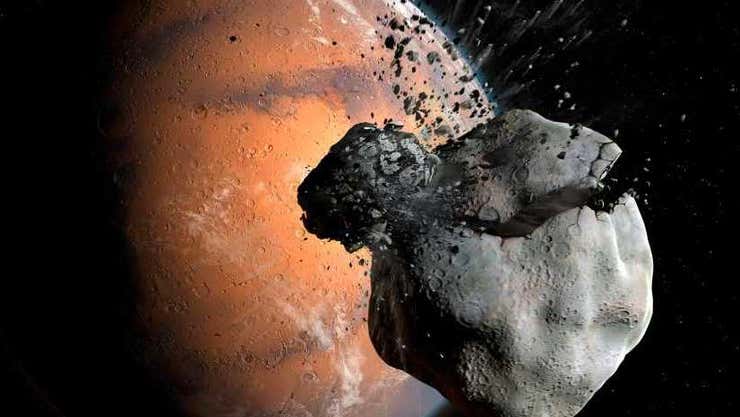 Computer Simulations Suggest Martian Moons Were Separated at Birth More Than a Billion Years Ago
Computer Simulations Suggest Martian Moons Were Separated at Birth More Than a Billion Years AgoResearchers are looking at different explanations for how the tiny moons of Mars, Phobos and Deimos, were created. Based on running computer simulations backwards, a new study in Nature Astronomy suggests that the Martian moons are the product of an ancient collision. Matija Ćuk, a research scientist at the SETI Institute, provides some push back on the findings.
Another possibility is that the two moons are the shattered remnants of an ancient collision, a hypothesis considered by Amirhossein Bagheri, a doctoral student at ETH Zurich and the lead author of a new Nature Astronomy paper on the subject.
While the study offers an intriguing look at the moons’ history, Matija Ćuk, a research scientist at the SETI Institute, wasn’t convinced by the findings. (Gizmodo)
- Gizmodo: Computer Simulations Suggest Martian Moons Were Separated at Birth More Than a Billion Years Ago
- SETI.org: Martian Moon’s Orbit Hints at an Ancient Ring of Mars
 The Curious Coincidences of Alpha Centauri
The Curious Coincidences of Alpha CentauriSome say stories of alien visitations dating from the middle of the last century to this decade can be attributed to our neighboring star system Alpha Centauri. Will the discovery of new planets in that region of space along with an interesting “second Wow!” signal spur more alien fascination and folklore, or change speculation to reality?
Prima facie, it is just our obsession with the alien mysteries to which Alpha Centauri plays an enabling host — too far to visit yet close enough to make up stories. For a while, the absence of any known planets in the system ensured the hoax stayed just that. But now we know of at least two planets in the system with one having some potential for life. The recent discovery of a “maybe” planet around Alpha Centauri also adds to this. Is it after all possible there is someone there? (Medium)
- Medium: The Curious Coincidences of Alpha Centauri
- SETI.org: Did Proxima Centauri Just Call to Say Hello? Not Really!
- SETI.org: A Signal from Proxima Centauri?
 SETI Institute and NASA team up to bring NASA science into the nation’s community colleges
SETI Institute and NASA team up to bring NASA science into the nation’s community collegesThe NASA Community College Network is an innovative program designed to bring NASA subject matter experts, research findings and educational resources into community college science classrooms across the nation.
“NASA’s Science Activation program brings the unmatched STEM resources of NASA to schools, libraries and communities across the United States.,” said Dr. Simon Steel, NCCN Principal Investigator. “NCCN will amplify this reach into America’s community colleges where many students from underserved groups start their higher education.” (Scienmag)
- Scienmag: SETI Institute and NASA team up to bring NASA science into the nation’s community colleges
- SETI.org: The NASA Community College Network: SETI Institute and NASA team up to bring NASA science into the nation’s community colleges
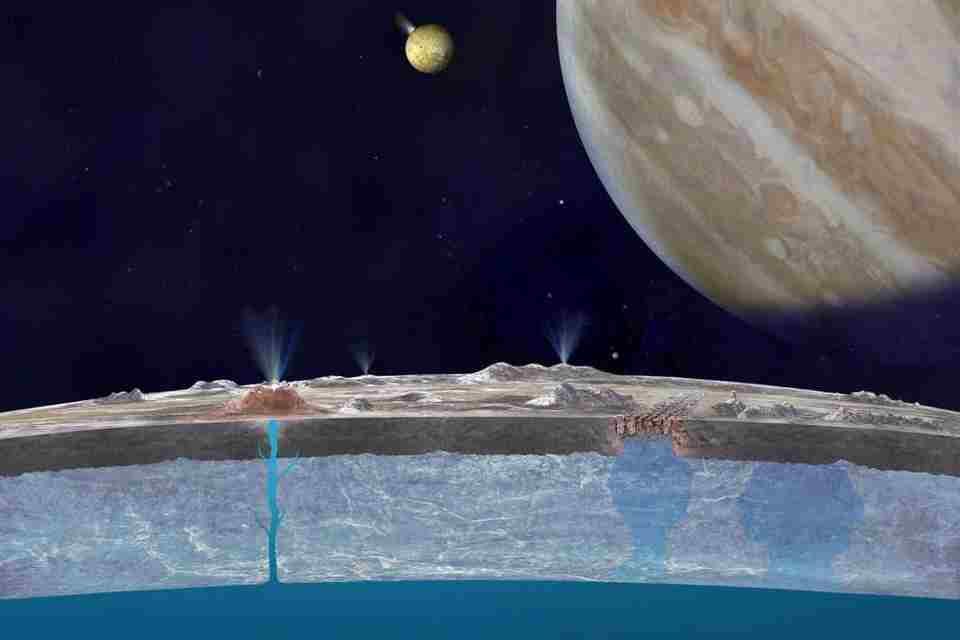 Scientists discover new evidence of habitable water ocean under Jupiter’s moon Europa
Scientists discover new evidence of habitable water ocean under Jupiter’s moon EuropaAfter reevaluating data collected by the Galileo obiter, scientists uncovered new evidence of vaper plumes stemming from a possible ocean under the icy surface of Jupiter’s moon Europa that could potentially support life.
…a new NASA model now supports the theory that the interior ocean in Jupiter’s moon Europa would be able to sustain life. They found that Europa could actually be the best place to look for alien life within our Solar System.
NASA scientists calculated the amount of water they believed to be an ocean under the surface ice shell, which could have been formed by the breakdown of water-containing minerals due to either tidal forces or radioactive decay.
…Jia’s team was inspired to dive back into the Galileo data by Melissa McGrath of the SETI Institute in Mountain View, California. A member of the Europa Clipper science team, McGrath delivered a presentation to fellow team scientists, highlighting other Hubble observations of Europa. (Tech Startups)
- Tech Startups: Scientists discover new evidence of habitable water ocean under Jupiter’s moon Europa
 What would a martian look like?
What would a martian look like?Now that the Perseverance Rover is hard at work searching for signs of life on Mars, scientists are weighing in on expectations of what evidence of life on Mars could look like.
This may be disappointing to people who are hoping to find more advanced civilizations. Yet Dr. Seth Shostak, a senior astronomer at the SETI [Search for Extra-Terrestrial Intelligence] Institute, told Salon that when it comes to Mars, "you can safely assume it never got past the stage of making bacteria — single-celled organisms."
Why?
"The food supply was probably not adequate and there wasn't enough time," Shostak explained. "Mars went bad rather quickly. Within a billion years after the birth of Mars, Mars was probably not a great place to live unless you were a bacteria." Those organisms, if they did live on Mars, "might have been in the lakes and rivers, and even the ocean that we think covered Mars was three and a half to four billion years ago." (AlterNet)
- AlterNet: What would a martian look like?
- SETI.org: Why Martian Pond Scum Would Change the World
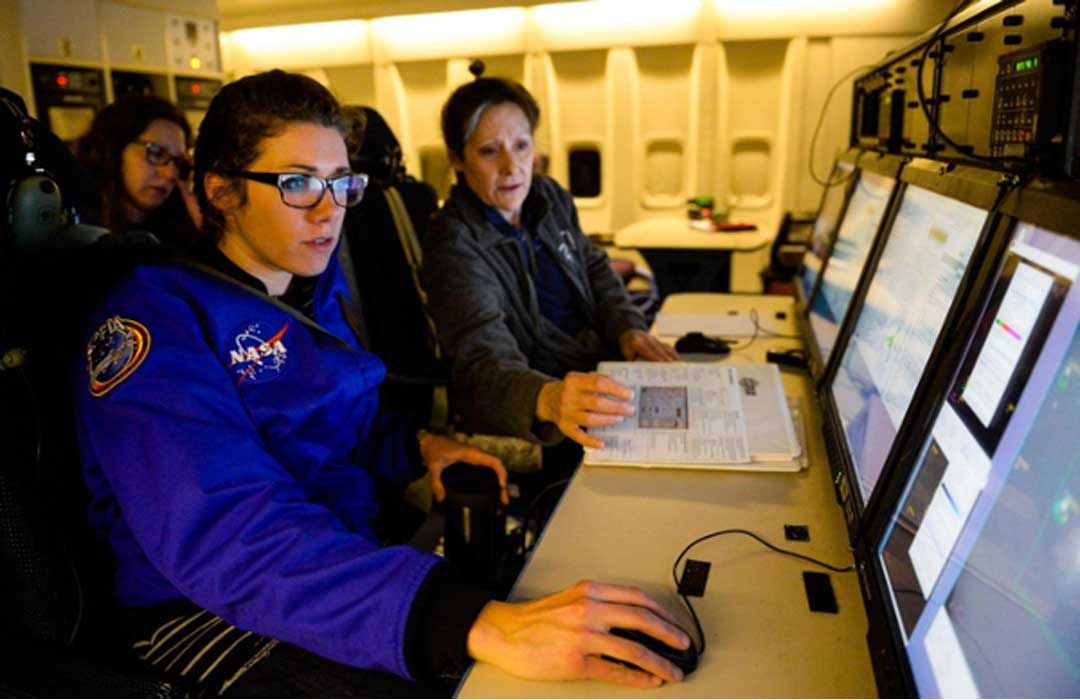 Utah teachers selected for NASA flight to the stratosphere
Utah teachers selected for NASA flight to the stratosphereLocal students are sharing in the excitement of two Utah teachers selected to be among 30 teachers from 10 states taking part in this year’s Airborne Astronomy Ambassadors (AAAs), a program bringing NASA science into classrooms. The AAA program, originally designed for high school teachers, has now been expanded to include middle school and community college teachers.
Castleton's students just learned that their robotics teacher will be taking a flight that nearly reaches outer space.
Sophomore Brayden Bacigalupo talked about the fun news that came on the heels of the NASA Mars Perseverance Rover successfully landing on the Red Planet.
"Just amazed that we were able to get something from NASA," he said.
It's a dream that Castleton explained he's been working to pursue for eight years.
Castleton and Corner Canyon High teacher Milo Maughan were two of 30 teachers selected from applicants across the country for the Airborne Astronomy Ambassadors program.
Maughan described how, as part of the program, they will spend the summer completing remote trainings and webinars with NASA. Then this fall, they'll immerse themselves at a NASA astronomy research facility for a week.
As part of that trip, they'll fly on a NASA plane called SOFIA (Stratospheric Observatory for Infrared Astronomy). Maughan explained that SOFIA is a Boeing 747SP modified to carry a giant infrared telescope in the back. (Fox 13 Salt Lake City)
- Fox 13 Salt Lake City: Utah teachers selected for NASA flight to the stratosphere
- SETI.org: 30 Teachers Selected as Airborne Astronomy Ambassadors to Bring NASA Science to Classrooms
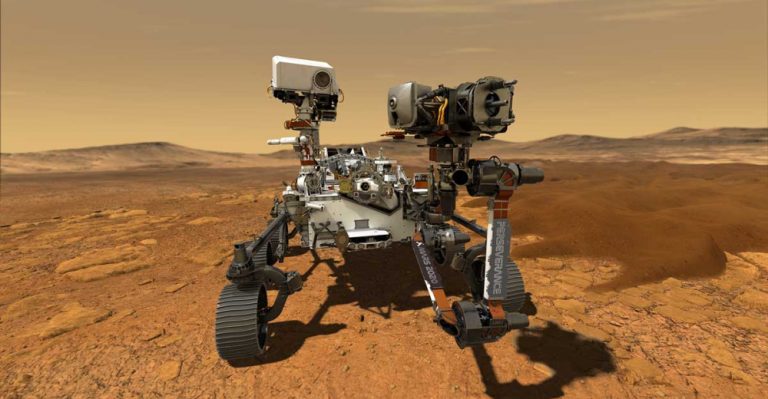 Canadian Tech Calling: Moon and Mars and Mobile Phones
Canadian Tech Calling: Moon and Mars and Mobile PhonesWith an eye on the Moon, Mars and beyond, researchers continue to make strides in expanding cellular and Wi-Fi networks.
A team of researchers at Simon Fraser University is working to make LTE/4G and Wi-Fi communications systems on the Moon a reality, along with others in the U.S. and Canada, under the umbrella of the Artemis Program at NASA.
…Braham and associate professor Peter Anderson, who directs the SFU Telematics Research Laboratory that includes PolyLAB, both have extensive track records working on communication systems for NASA and the Canadian Space Agency (CSA).
It includes extensive research on very early cellular and Wi-Fi networks in the Canadian High Arctic, where advanced field communications systems were set up to support the SETI Institute and Mars Institute-lead NASA Haughton-Mars Project (HMP) up on Devon Island. (WhatsYourTech.ca)
- WhatsYourTech.ca: Canadian Tech Calling: Moon and Mars and Mobile Phones
Ever since our ancient ancestors gazed into the night skies to look at stars, and other celestial objects, humans have wondered if we are alone in the cosmos. Seth Shostak, senior astronomer at the SETI Institute joins Rick Pantaleo on the Science Edition of Press Conference USA to talk about the search for extraterrestrial intelligence. (Player FM)
- Player FM: The Search for Extraterrestrial Intelligence
Creature Discomforts
Okay you animals, line up: stoned sloths, playful pandas, baleful bovines, and vile vultures. We’ve got you guys pegged, thanks to central casting.
Or do we? Our often simplistic view of animals ignores their remarkable adaptive abilities. Stumbly sloths are in fact remarkably agile and a vulture’s tricks for thermoregulation can’t be found in an outdoors store.
Our ignorance about some animals can even lead to their suffering and to seemingly intractable problems. The South American nutria was brought to Louisiana to supply the fur market. But the species got loose and tens of millions of these rodents are destroying the environment. It literally has a bounty on its tail.
Hear about research that corrects a menagerie of misunderstandings about our fellow furry, feathered, and scaly animals, and how getting over ourselves to know them better can have practical benefits. Will you still recoil from termites if you learn that they are relevant to the future of robots, global warming, and smart design?
Join guests Lucy Cooke, Chris Metzler and Lisa Margonelli for a look at how understanding animals better can be mutually beneficial in Creature Discomforts.
For more information and the archive of past shows, visit the Big Picture Science website.
Recent SETI Live episodes include:
- Mars 2020 – The Perseverance Rover Landing! NASA’s Mars 2020 mission, including the Perseverance rover, is about to reach its destination: The Jezero crater on Mars.
Join us live on February 18 between 11:15am and 12:45pm PST to follow the landing and hear from engineers and scientists directly involved in the mission. Franck Marchis, a senior astronomer at the SETI Institute, and Beth Johnson, a social media expert at the SETI Institute, will host this special SETI Live.
Scheduled Guests:
Adrian Brown, NASA HQ, Deputy Program Scientist, Mars 2020
Janice Bishop, SETI Institute, Senior Research Scientist
Elena Amador-French, JPL, Systems Engineer and Planetary Scientist
David Deamer, UCSC, Research Professor
Bruce Damer, UCSC, Research Associate
Joby Hollis, JPL, Postdoctoral Scholar
Pascal Lee, SETI Institute, Planetary Scientist
Casey Moore, Maxar Space Robotics, Space environments specialist
Stephan Hunker, Maxar Space Robotics, Mechanical engineering manager
Troy Hudson, JPL, Instrument System Engineer
David Stafford, JPL, Mechanical Integration Engineer
Bill Diamond, SETI Institute, CEO
Nathalie Cabrol, SETI Institute, Director of the Carl Sagan Center
Guests will discuss their roles with Mars 2020 and Perseverance. These include the site selection, the goal of the mission, some of the instruments onboard the rover, and of course the future of Mars exploration. Remember, landing on Mars is hard, so we need your support.
Franck Marchis was hosted at The Archery, a shared workspace in the mission district of San Francisco that houses a public cafe, an exhibition space and supports a community of entrepreneurs, makers and artists. Special thanks to our production members, Pocket Pictures for A/V support.
What to expect: Perseverance is scheduled to touch down on Mars on Thursday, Feb. 18, 2021, at approximately 12:55 p.m. PST (3:55 p.m. EST). During landing, the rover plunges through the thin Martian atmosphere, with the heat shield first, at a speed of over 12,000 mph (about 20,000 kph). A parachute and powered descent slow the rover down to about 2 mph (three-fourths of a meter per second) – this is sometimes referred to as “7 minutes of terror.” A large sky crane then lowers the rover on three bridle cords to land softly on six wheels. Landing on Mars is hard!
During the landing, we will share NASA’s stream so we can all watch together.
https://mars.nasa.gov/mars2020/timeli...
As always, videos of all past Facebook Live events can be found on our Facebook page: https://www.facebook.com/SETIInstitute/ Or on our YouTube channel: https://www.youtube.com/SETIInstitute





